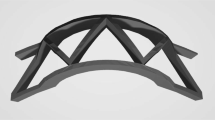Abstract
This paper presents an algorithm to automatically generate optimal tool-paths for the wire and arc additive manufacturing (WAAM) process for a large class of geometries. The algorithm firstly decomposes 2D geometries into a set of convex polygons based on a divide-and-conquer strategy. Then, for each convex polygon, an optimal scan direction is identified and a continuous tool-path is generated using a combination of zigzag and contour pattern strategies. Finally, all individual sub-paths are connected to form a closed curve. This tool-path generation strategy fulfils the design requirements of WAAM, including simple implementation, a minimized number of starting-stopping points, and high surface accuracy. Compared with the existing hybrid method, the proposed path planning strategy shows better surface accuracy through experiments on a general 3D component.
Similar content being viewed by others
References
Lipson H (2012) Frontiers in additive manufacturing. Bridge 42:5–12
Agarwala M et al (1995) Direct selective laser sintering of metals. Rapid Prototyp J 1:26–36
Lewis GK, Schlienger E (2000) Practical considerations and capabilities for laser assisted direct metal deposition. Mater Des 21:417–423
Taminger KM, and Hafley RA 2003 Electron beam freeform fabrication: a rapid metal deposition process. In Proceedings of the 3rd Annual Automotive Composites Conference, pp. 9–10
Merz R et al (1994) Shape deposition manufacturing. Engineering Design Research Center, Carnegie Mellon Univ
Almeida PS, Williams S (2010) Innovative process model of Ti–6Al–4V additive layer manufacturing using cold metal transfer (CMT). In Proceedings of the Twenty-first Annual International Solid Freeform Fabrication Symposium, University of Texas at Austin, Austin, TX, USA, 2010
Ding J et al (2011) Thermo-mechanical analysis of wire and arc additive layer manufacturing process on large multi-layer parts. Comput Mater Sci 50:3315–3322
Wang F et al (2011) Morphology investigation on direct current pulsed gas tungsten arc welded additive layer manufactured Ti6Al4V alloy. Int J Adv Manuf Technol 57:597–603
Suryakumar S et al (2011) Weld bead modeling and process optimization in hybrid layered manufacturing. Comput Aided Des 43:331–344
Martina F et al (2012) Investigation of the benefits of plasma deposition for the additive layer manufacture of Ti–6Al–4V. J Mater Process Technol 212:1377–1386
Zhang Y et al (2003) Weld deposition-based rapid prototyping: a preliminary study. J Mater Process Technol 135:347–357
Xiong X et al (2009) Metal direct prototyping by using hybrid plasma deposition and milling. J Mater Process Technol 209:124–130
Karunakaran K et al (2010) Low cost integration of additive and subtractive processes for hybrid layered manufacturing. Robot Comput Integr Manuf 26:490–499
Dunlavey MR (1983) Efficient polygon-filling algorithms for raster displays. ACM Trans Graph 2:264–273
Park SC, Choi BK (2000) Tool-path planning for direction-parallel area milling. Comput Aided Des 32:17–25
Rajan V et al (2001) The optimal zigzag direction for filling a two-dimensional region. Rapid Prototyp J 7:231–241
Farouki R et al (1995) Path planning with offset curves for layered fabrication processes. J Manuf Syst 14:355–368
Yang Y et al (2002) Equidistant path generation for improving scanning efficiency in layered manufacturing. Rapid Prototyp J 8:30–37
Li H et al (1994) Optimal toolpath pattern identification for single island, sculptured part rough machining using fuzzy pattern analysis. Comput Aided Des 26:787–795
Wang H et al (2005) A metric-based approach to two-dimensional (2D) tool-path optimization for high-speed machining. Trans Am Soc Mech Eng J Manuf Sci Eng 127:33
Ren F et al (2009) Combined reparameterization-based spiral toolpath generation for five-axis sculptured surface machining. Int J Adv Manuf Technol 40:760–768
Kulkarni P et al (2000) A review of process planning techniques in layered manufacturing. Rapid Prototyp J 6:18–35
Bertoldi M, et al (1998) Domain decomposition and space filling curves in toolpath planning and generation. In Proceedings of the 1998 Solid Freeform Fabrication Symposium, The University of Texas at Austin, Austin, Texas, 1998, pp. 267–74
Chiu W et al (2006) Toolpath generation for layer manufacturing of fractal objects. Rapid Prototyp J 12:214–221
Wasser T et al (1999) Implementation and evaluation of novel buildstyles in fused deposition modeling (FDM). Strain 5:6
Dwivedi R, Kovacevic R (2004) Automated torch path planning using polygon subdivision for solid freeform fabrication based on welding. J Manuf Syst 23:278–291
Jin G et al (2013) An adaptive process planning approach of rapid prototyping and manufacturing. Robot Comput Integr Manuf 29:23–38
Sheng W et al. (2003) Surface partitioning in automated CAD-guided tool planning for additive manufacturing, in intelligent robots and systems, 2003.(IROS 2003). Proceedings. 2003 IEEE/RSJ International Conference on, pp. 2072–2077
Keil JM (2000) Polygon decomposition. Handb Comput Geom 2:491–518
Volpato N et al (2013) Identifying the directions of a set of 2D contours for additive manufacturing process planning. Int J Adv Manuf Technol 68:33–43
De Berg M, et al. (eds) (2000) Computational geometry. Springer, Berlin
Author information
Authors and Affiliations
Corresponding author
Rights and permissions
About this article
Cite this article
Ding, D., Pan, Z.(., Cuiuri, D. et al. A tool-path generation strategy for wire and arc additive manufacturing. Int J Adv Manuf Technol 73, 173–183 (2014). https://doi.org/10.1007/s00170-014-5808-5
Received:
Accepted:
Published:
Issue Date:
DOI: https://doi.org/10.1007/s00170-014-5808-5




